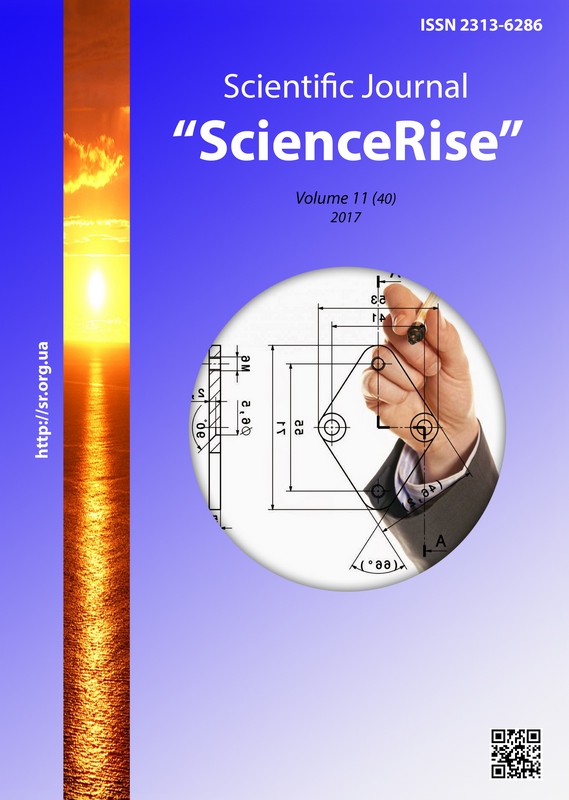Research of the exposure impact on mycobacteria ultrastructure and variability
DOI:
https://doi.org/10.15587/2313-8416.2017.116675Keywords:
tuberculosis, strains, mycobacterium, M. bovis, M. scrofulaceum, M. intracellularae, electron microscopy, ionizing radiationAbstract
Materials presented in the study show that small doses of radiation do not cause changes in the ultrastructure of Mycobacterium bovis and atypical mycobacteria, stimulate only their reproductive activity (Mycobacterium Intracellularae), but they lead to changes in the shape and electron optical density of the cytoplasm in Mycobacterium scrofulaceum. The dose at which mycobacteria acquire degenerative changes is 154,8 – 206,4 C/kg (600000 – 800000 R)
References
Feshchenko, Yu. I. (2016). Pohliad na problemu borotby z tuberkulozom v Ukraini. Ukrainskyi pulmonolohichnyi zhurnal, 3, 5–10. Available at: http://lib.inmeds.com.ua:8080/jspui/handle/lib/3458
Fujiwara, P. I., Olea-Popelka, F. (2016). Editorial Commentary: Why It Is Important to DistinguishMycobacterium bovisas a Causal Agent of Human Tuberculosis. Clinical Infectious Diseases, 63 (5), 602–603. doi: 10.1093/cid/ciw374
Yelk Woodruff, R. S., Pratt, R. H., Armstrong, L. R. (2015). The US National Tuberculosis Surveillance System: A Descriptive Assessment of the Completeness and Consistency of Data Reported from 2008 to 2012. JMIR Public Health and Surveillance, 1 (2), e15. doi: 10.2196/publichealth.4991
Ustinov, O. V. (2017). MOZ Ukrainy povidomliaie po rozroblennia kontseptsiy prohramy protydiy tuberkulozu. Ukrainskyi medychnyi chasopys. Available at: http://www.umj.com.ua/article/104403/moz-ukrayini-povidomlyaye-po-rozroblennya-kontseptsiyi-programi-protidiyi-tuberkulozu
Kundiyev, Yu. I., Andreichyn, M. A., Nahorna, A. M., Varyvonchyk, D. V. (2014). Profesiyni infektsiyni khvoroby. Kyiv: VD «Avitsena», 529.
Lan, Z., Bastos, M., Menzies, D. (2016). Treatment of human disease due toMycobacterium bovis: a systematic review. European Respiratory Journal, 48 (5), 1500–1503. doi: 10.1183/13993003.00629-2016
Melnyk, V. M., Novozhylova, I. O., Matusevych, V. H., Prykhodko, A. M., Bushura, I. V. (2013). Khimiorezystentnyi tuberkuloz: poshyrenist ta profil stiykosti mikobakteriy tuberkulozu do antymikobakterialnykh preparative. Ukrainskyi pulmonolohichnyi zhurnal, 3, 19–23.
Kassich, Yu. Ya., Borzyak, A. T., Kochmarskiy, A. F. et. al.; Kassich, Yu. Ya. (Ed.) (1990). Tuberkulez zhivotnyh i mery bor'by s nim. Kyiv: "Urozhay", 304.
Tarekegn, B. G. (2013). Factors affecting the frequency of lipid body positive tubercle bacilli in human sputum. Leicester, 310. Available at: http://hdl.handle.net/2381/28630
Stehniy, B. T., Zavhorodniy, A. I., Kalashnyk, M. V. (2014). Vyznachennia pryrody reaktsiy na tuberkulin u velykoi rohatoi khudoby. Veterynarna medytsyna, 99, 86–89.
Kassich, V. Yu. (2004). Minlyvist mikobakteriy, epizootolohichnyi monitorynh, zasoby i zakhody borotby z tuberkulozom tvaryn v umovakh radiatsiinoho vplyvu. Kharkiv, 408.
Blashchuk, V. (2015). Vvyzhyvannia (adaptohennist) mikobakteriy u vidkhodakh tvarynnytstva za vplyvu elektromahnitnoho oprominennia. Naukovyi visnyk LNUVMBT imeni S. Z. Gzhytskoho, 17 (3 (63)), 130–133.
Moiseienko, T. M., Volianskyi, A. Yu., Kovalova, H. O. (2015). Vyznachennia neobkhidnykh rezhymiv ultrafioletovoho oprominiuvannia, yaki zapobihaiut vyzhyvanniu Mycobacterium tuberculosis ta peretvorenniu yikh v L-formy. Annaly Mechnykovskoho instytutu, 1, 60–65.
Jeevan, A., Sharma, A. K., McMurray, D. N. (2009). Ultraviolet radiation reduces resistance to Mycobacterium tuberculosis infection in BCG-vaccinated guinea pigs. Tuberculosis, 89 (6), 431–438. doi: 10.1016/j.tube.2009.09.004
Salyha, Yu. T., Snitynskyi, V. V. (1999). Elektronna mikroskopiya biolohichnykh obiektiv. Lviv, 152.
Li, Z. (2002). Industrial applications of electron microscopy. CRC Press, 644. doi: 10.1201/9780203910306
Korzhevskiy, D. Eh. (Ed.) (2017). Morfoogicheskaya diagnostika. Podgotovka materiala dlya gistologicheskogo issledovaniya i ehlektronnoy mikroskopii. Sankt-Peterburg: SpecLit, 127.
Downloads
Published
Issue
Section
License
Copyright (c) 2017 Volodymyr Kassich, Ann Levchenko, Yurii Baydevliatov, Ghalina Rebenko, Valerii Golovko, Oleksii Kassich, Valerii Ushkalov, Olena Volosianko

This work is licensed under a Creative Commons Attribution 4.0 International License.
Our journal abides by the Creative Commons CC BY copyright rights and permissions for open access journals.
Authors, who are published in this journal, agree to the following conditions:
1. The authors reserve the right to authorship of the work and pass the first publication right of this work to the journal under the terms of a Creative Commons CC BY, which allows others to freely distribute the published research with the obligatory reference to the authors of the original work and the first publication of the work in this journal.
2. The authors have the right to conclude separate supplement agreements that relate to non-exclusive work distribution in the form in which it has been published by the journal (for example, to upload the work to the online storage of the journal or publish it as part of a monograph), provided that the reference to the first publication of the work in this journal is included.

